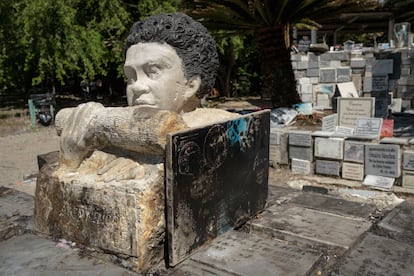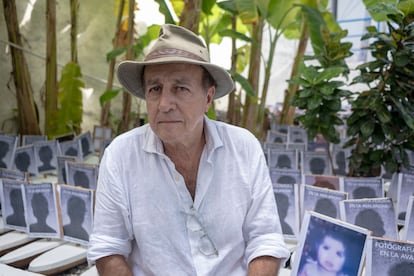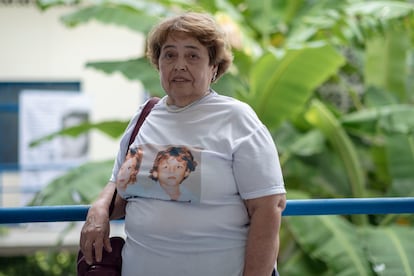Benjamín Herrera had been married for three years the first time he spent a night away from home. That day, he had worked all day in a sorghum field and, when the work was finished, he was told that he had to replace the person who monitored the company’s machinery at night. His wife and his 14-month-old son Óscar Fernando remained in their home in Armero. He had greeted them in the morning. It was November 13, 1985. While Herrera was away, the Nevado del Ruiz volcano erupted and triggered an avalanche that swept away the city, in the natural disaster that caused the greatest number of deaths in Colombia’s history. His wife is dead. His son is one of Armero’s 583 missing children: minors given up for adoption, in many cases, irregularly, one of the great pains left by the catastrophe. The search for the families and their demand for justice begins this Wednesday on the occasion of the 40th anniversary of the Armero tragedy.
The commemorations, full of symbolic charge, were led by the Armando Armero Foundation, which since 2012 has led the search for the hundreds of minors missing in the tragedy that the State has never traced. The faces of each of those children, whose fate is still unknown, were the sails of two small wooden boats that were thrown into the Gualí River, a few meters from its mouth in the Magdalena River, Colombia’s water column. There, in the municipality of Honda, tangentially affected by the avalanche that killed Armero, the relatives who continue the search try to shake off the apathy and oblivion of one of the many wounds that Ruiz left open in 1985 and which have not yet been healed.
Armero, a hard blow for a fallen country
The Armero tragedy was a mortal blow for Colombia, a country that was looking into the abyss that month of November 1985. A week earlier, a commando of M-19 guerrillas had attacked the Palace of Justice in Bogota and taken the magistrates of the High Court hostage. The army responded with a brutal takeover that exacerbated the terror. These wounds also remain open, and stories about responsibility and culprits have fueled today’s political controversies, like so many issues in Colombia. Armero’s avalanche left the country on the brink of collapse.
After an increase in ash rain falling on the city of Tolima, the Nevado del Ruiz erupted around 9.30pm. on November 13th. The heat of the Arenas crater melted part of the ice that lay on the summit, and the water began to swell the tributaries that originated from there. The avalanche descended through the channels of the Lagunilla and Gualí rivers, dragging with it vegetation and rocks weighing several tons. Around 11pm, the Lagunilla devastates Armero, in a catastrophe aggravated in part by the mix of unheeded warnings, which invite calm and contradictory news. It was, as has been said several times, a tragedy foretold. And he repeated: Ruiz had already destroyed two towns located in the same place, although much smaller, in 1595 and 1845.
Night had fallen on a prosperous town, famous for its cotton plantations, of almost 30,000 inhabitants, a commercial reference in the department of Tolima. The dawn of the next day revealed to the world the worst face of tragedy and devastation. The musician Rodrigo Silva would later sing that Armero of the past in his Claim Godit no longer existed. One of the first descriptions of what remained was made by pilot Fernando Rivera, who saw the extent of the disaster aboard a fumigated plane and told it to journalist Yamid Amat on Caracol Radio’s morning broadcast:
“Armero was almost 100% destroyed,” Rivera said.
―What kind of description could you give of what you observed? «Amat asked himself, perhaps without yet understanding the tragedy.
-It was all mud. He erased houses, he erased everything. Everyone has disappeared. I believe there will be… not even 5% of Armero’s number will be alive.
—But could you tell us how many people died?
-The best way is to find out how many inhabitants Armero had and from there calculate that there are not even 2% of the inhabitants survived. The others, almost all, died.
As the hours passed, Colombia began to understand the severity of the disaster. The worldwide resonance of the news would arrive a couple of days later, with the image of a girl who had water above her chest and could not free herself from the mud and debris that kept her imprisoned. It was Omayra Sánchez, 13 years old, who was the face of the tragedy and who was trapped for almost three days, in front of the cameras, until her death on November 16th. In the midst of the weeds and thick foliage that today governs what was Armero, the place of his agony is marked, which, 40 years later, is a place of pilgrimage full of stuffed animals, flowers, rosaries, dolls, ringlets and plaques of thanks for the miracles attributed to him.

The avalanche was, in turn, the mother of other tragedies. That of those who have never had news of their relatives who were in Armero. That of corruption, bureaucracy and lack of transparency on the destination of the aid received to assist the victims and survivors. Or that of the missing children honored and vindicated this Wednesday in Honda, about 50 kilometers north of the disaster site.
The biggest wound
Francisco González, director of the Armando Armero Foundation, lost several family members in the tragedy that wiped out his city. Since 2012, when he began his work, he has been the visible face of the search for missing children who, in his opinion, represent the biggest wound left by the catastrophe. “We have around 150 emblematic cases, in which we can demonstrate, with testimonies and images from the time, that they came out alive”, he says shortly before starting to throw the barges into the waters of the Gualí. “In our database we have 583 minors reported who belong to more than 400 families. We have the DNA of all of them, and also of 71 adopted ones”, he adds. According to what he says there were four reunions thanks to the DNA test.
González celebrates the presence of the Colombian Institute of Family Assistance (ICBF) and announces an agreement with that institution, responsible for child welfare, to continue his research. “Previously, the directors of the ICBF turned their backs on us. Through the right of petition they denied us absolutely everything, did not recognize anything. When the current director began to review, he agreed with us,” he says. He also believes that the next step is to open an investigation to get to the truth about what he considers to be a drama that affects the entire world. “Why? Because Armero’s children were adopted through regular and irregular channels in countries like Spain, Holland, France or Denmark.”

ICBF director Astrid Cáceres acknowledged that the institute has been criticized many times for failing to take care of missing children. For this reason, and after a couple of years of contact with Armando Armero, they have agreed on a joint working protocol in which both the ICBF and the foundation hope to collaborate on research. Additionally, your participation in Honda tributes is a way to do a my fault and have a new attitude towards a drama that is still alive: “We hope to contribute to the reconstruction of memory and that this path we open leads to truth and tranquility for families”, he says.
On the other hand, Cáceres explains that not all the children who left Armero alive remained in the custody of the ICBF. “The media at the time asked the families of the country to welcome the children and the foster care was authorized. We found it in the press. Then we discovered that the press was also launching appeals to return them. So there could have been many things in that fragment.” Not everyone returned to high school, he says. So now we need to see if they managed to reunite with their family and if the appropriate protocols were put in place in a country that at the time did not have clear laws on adoption. “We will have to see and investigate what happened to those children. If there is something wrong, we will also have to know it and judge it appropriately.”
Another face of this drama is María Gladys Primo, who was 22 years old when she lost everything. At the time of the avalanche she was with her husband, her brother and her two children, Nubia Isabel, six years old, and Jesús Manuel, seven. They had tried to save themselves on the second floor of their house, useless in the face of the violence of the mud that dragged walls, ceilings and cars with it. So she decided to stay with her husband and leave her two children in the care of her brother. He never saw the children again, at least in person: he saw Manuel again in 2012, in a video that a news program had recorded on the day of the tragedy. It was proof that he had survived. His version is complemented by the one his mother had given him: the children had passed an ICBF headquarters in Bogotá and were taken away. It was the last time he heard from them.

Primo tells his story with a stoicism that nevertheless reveals a mix of emotions. She spent a year and a half hospitalized, in a coma, after leaving Armero alive. She recovered from a serious leg injury suffered by the time she was rescued. His skin was falling apart, affected by the very high temperature of the mud. Having survived while 25,000 people died seems to give him the impulse to speak out and lead the human chain that descended, hand in hand, onto the barges with the faces of missing children, and that weaved among the stones, water and brushwood, and in the suffocating heat. These barges seem to become the only means that, after four decades, parents have left to feel their lost children in their hands again. At least for now.



